White rice has always been the centrepiece of my family meals, either paired with Western dishes or with something we would make from the “ethnic aisle.” As a mixed Chinese and Japanese Canadian, white rice was always eaten with something saucy and meaty, and never plain.
The starchy grain, served with gravy, was the highlight of my holiday meals growing up. I mentioned this to a friend once who quickly responded, “But don’t you just eat rice with soy sauce?”
I shook my head. Of all things I ate with rice, soy sauce was not one of them.
A few years later, I visited eastern Canada and learned one of my cousins ate rice almost exclusively with butter. This probably surprised me as much as my choice of rice and gravy surprised my friend.
While one meal might be seen as normal for one person, it may be seen as completely strange to another.
I started to wonder if other households blended foods too, whether through cultures or migration experiences. In the Japanese Canadian community, for example, I’ve heard stories of hot dogs wieners used as substitutes for tofu after the Second World War.
I decided to hunt down dishes created from cultural crossovers, limited access to ingredients, assimilation and colonization.
I met with five individuals living in Vancouver, who invited me into their homes to share their blended dishes and stories.
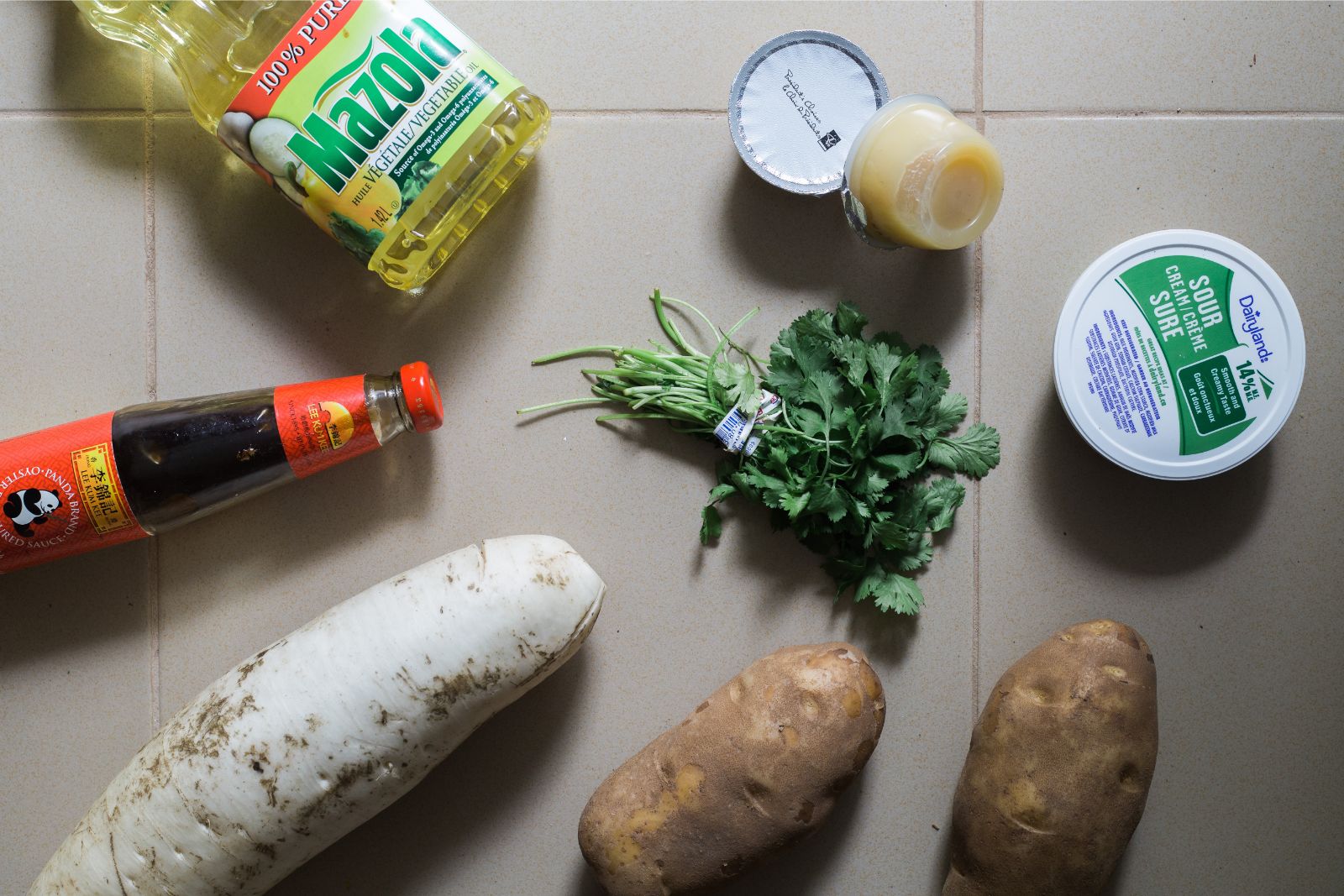
Daikon latkes
In a basement suite east of Broadway and Cambie in Vancouver, Kyla Yin, 22, peels the skin from a freshly washed potato over her kitchen sink. To her left sits a large daikon, or Japanese radish, among a bag of cilantro, a six-pack of applesauce cups, sour cream and oyster sauce.
“I’m making potato latkes,” she explains. “The other dish I’m making is my mom’s adaptation of that, which uses shredded daikon instead of potatoes.”
Traditionally a Jewish dish served during Hanukkah, latkes are fried potato pancakes served with sides of applesauce and sour cream. Yin’s version honours both her Jewish and Chinese roots.
“[Latkes] aren’t something [my mom] grew up with culturally, so she looked at it and she thought, ‘OK, I understand this is a cultural food, but also eating a bunch of fried potatoes as a meal doesn’t seem very healthy,’” says Yin, whose mom is a first-generation immigrant from China.
Yin’s mom also hates potatoes. During the Cultural Revolution in the 1960s and 1970s, she was forced to eat them as food was rationed.
“For her, potatoes have this memory of struggle. Potatoes aren’t fun for her,” says Yin, who noted how commonly they’re used on the Jewish side of her family.
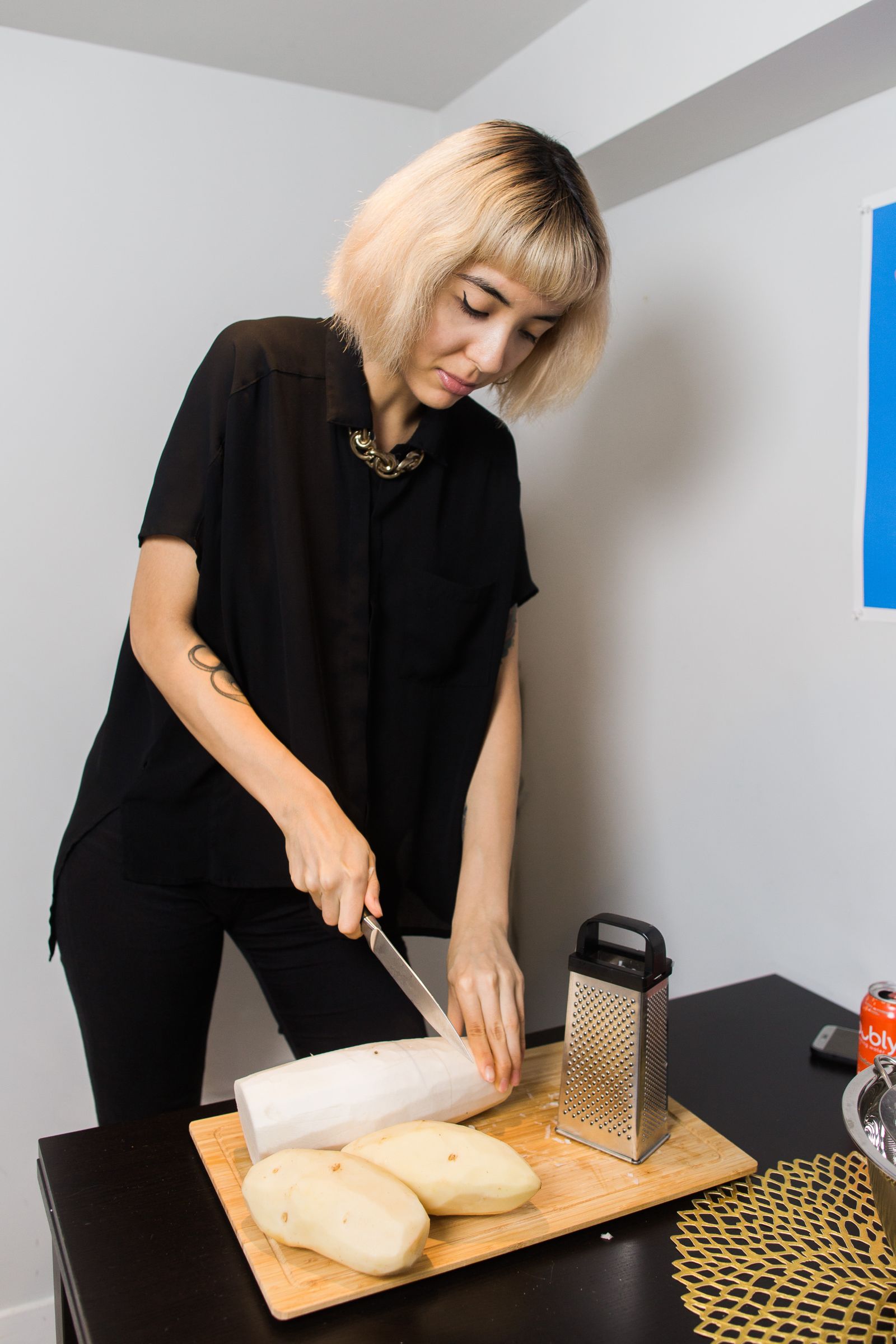
Once the potatoes and daikon are peeled, Yin finds a grater from a kitchen cabinet and places it on the table. Adding a metal bowl, strainer, and chopping board, she’s ready to begin slicing and grating the vegetables.
It’s a long, intensive process, which later involves squeezing the moisture from the grated vegetables. Once finished with the potatoes, she uses a second vessel and strainer to restart the process with the daikon.
Peel, grate, squeeze, repeat.
Next, she rolls and flattens the grated vegetables into pancakes, adding egg to the daikon. Using paper towels, she squeezes more liquid out. Once ready, they’re tossed into a frying pan with hot oil.
Yin fries the daikon latkes first. For a few minutes, they’re left on the stove to brown. Flipping them over reveals the difference in cooking the two: The daikon doesn’t stick together like the potatoes.
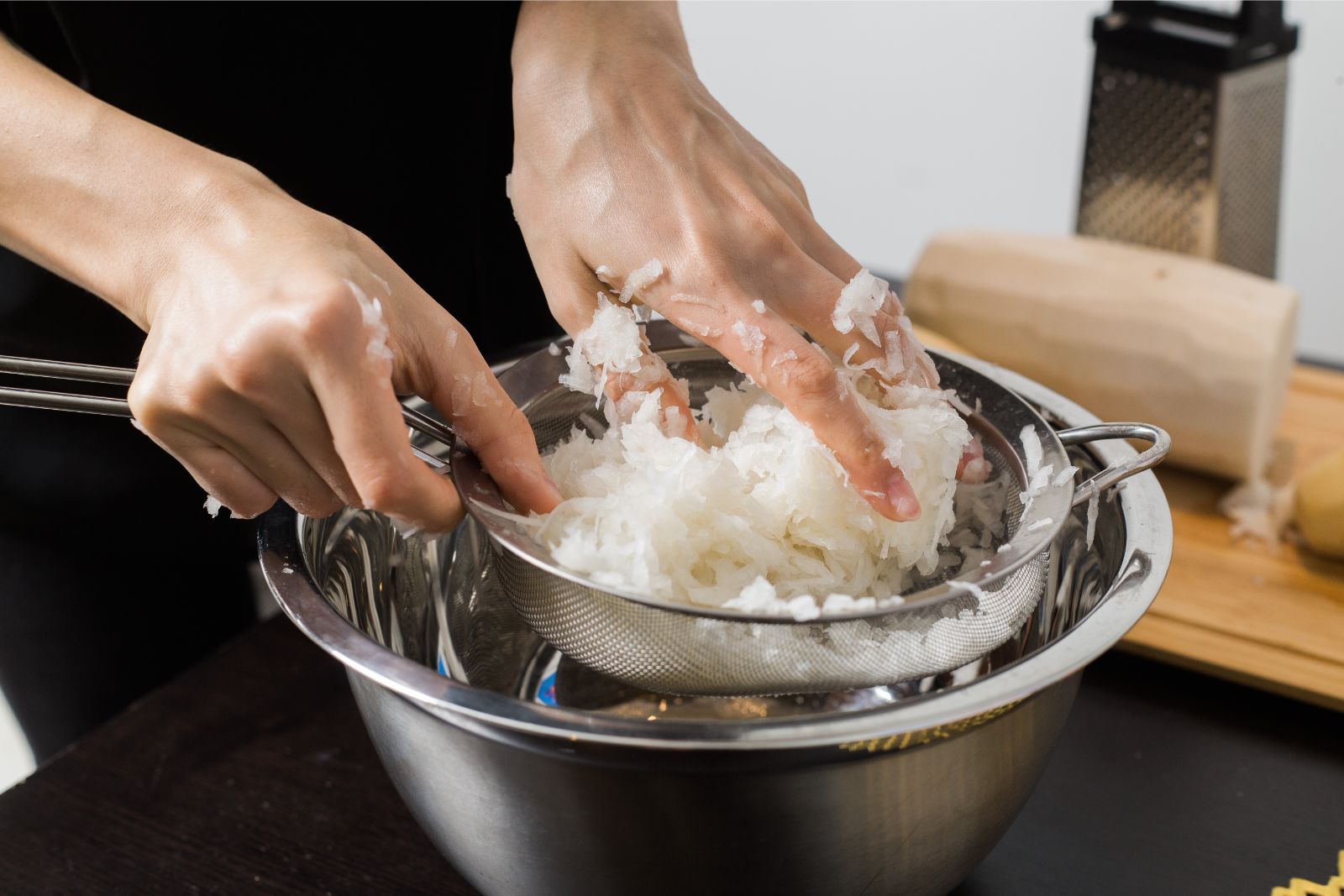
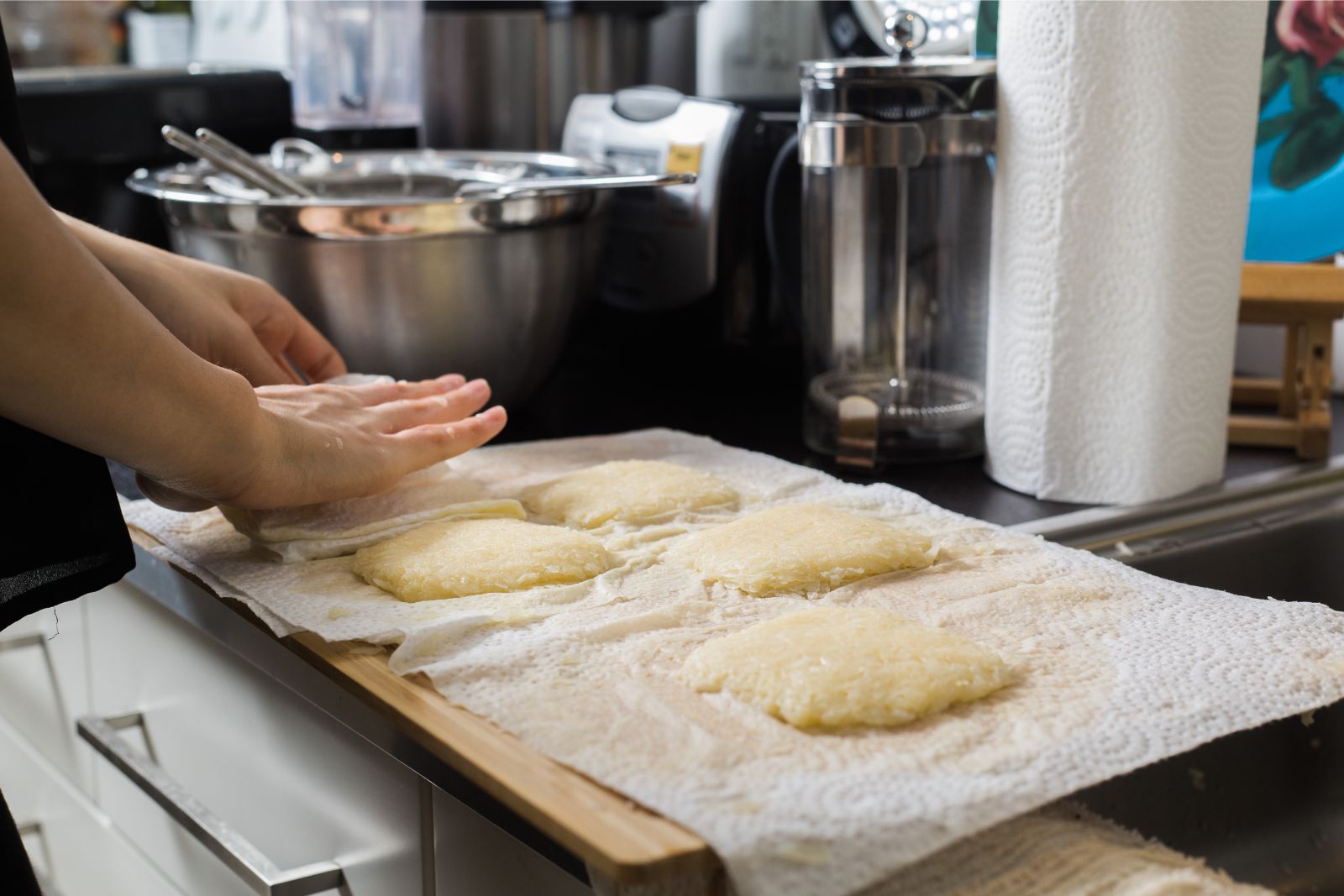
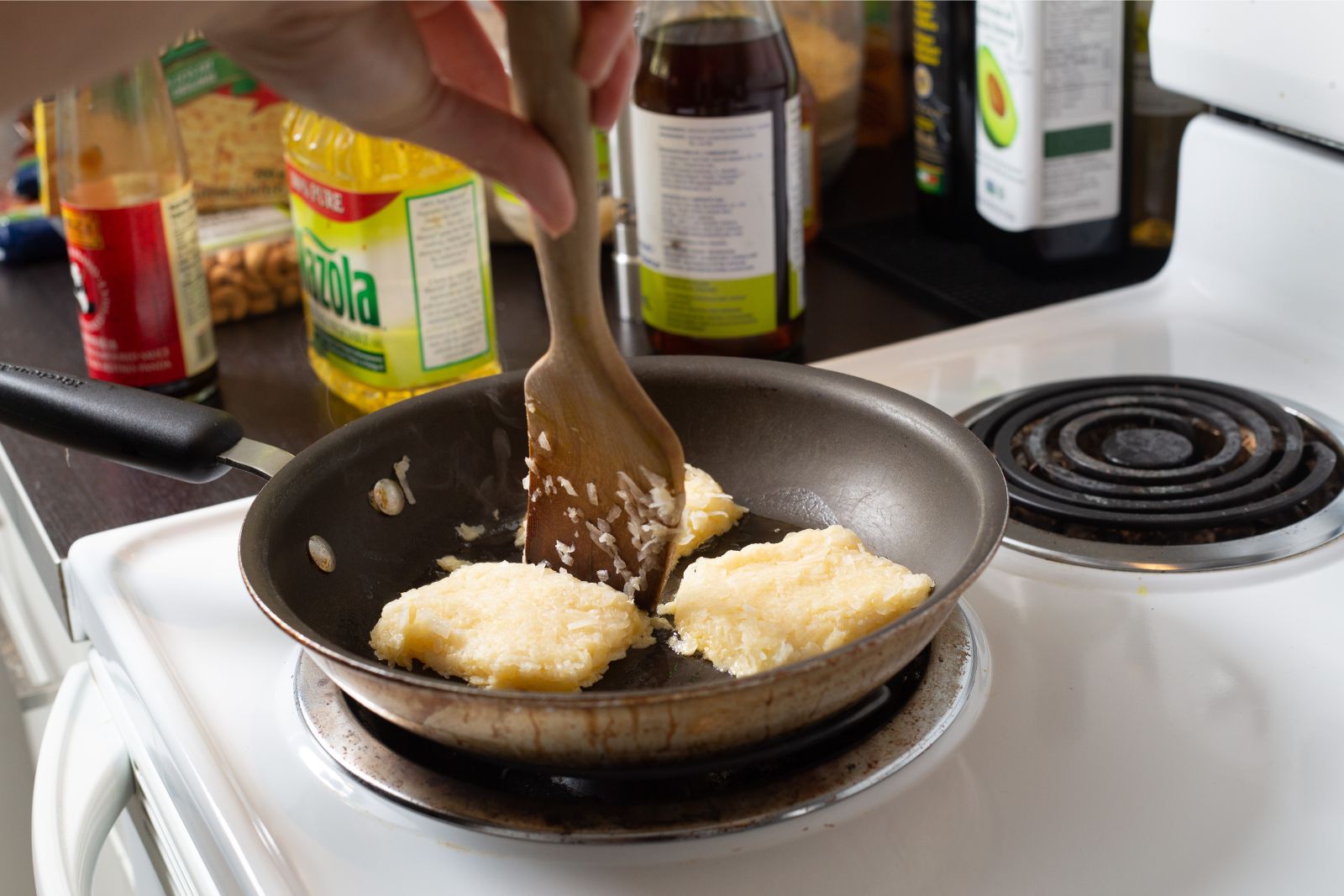
The first few turn into a daikon hash-brown scramble, but the second batch is flipped with a little more care, in an attempt to keep the pancakes together.
Yin says daikon latkes were the first thing to come to mind when thinking about blended food, because they provide the most cultural context when celebrating a holiday, and honour all traditions involved.
“When I think about this dish, especially the daikon version, I just think about that spirit of coming to a new country and trying to figure out how to do things your way,” she says.
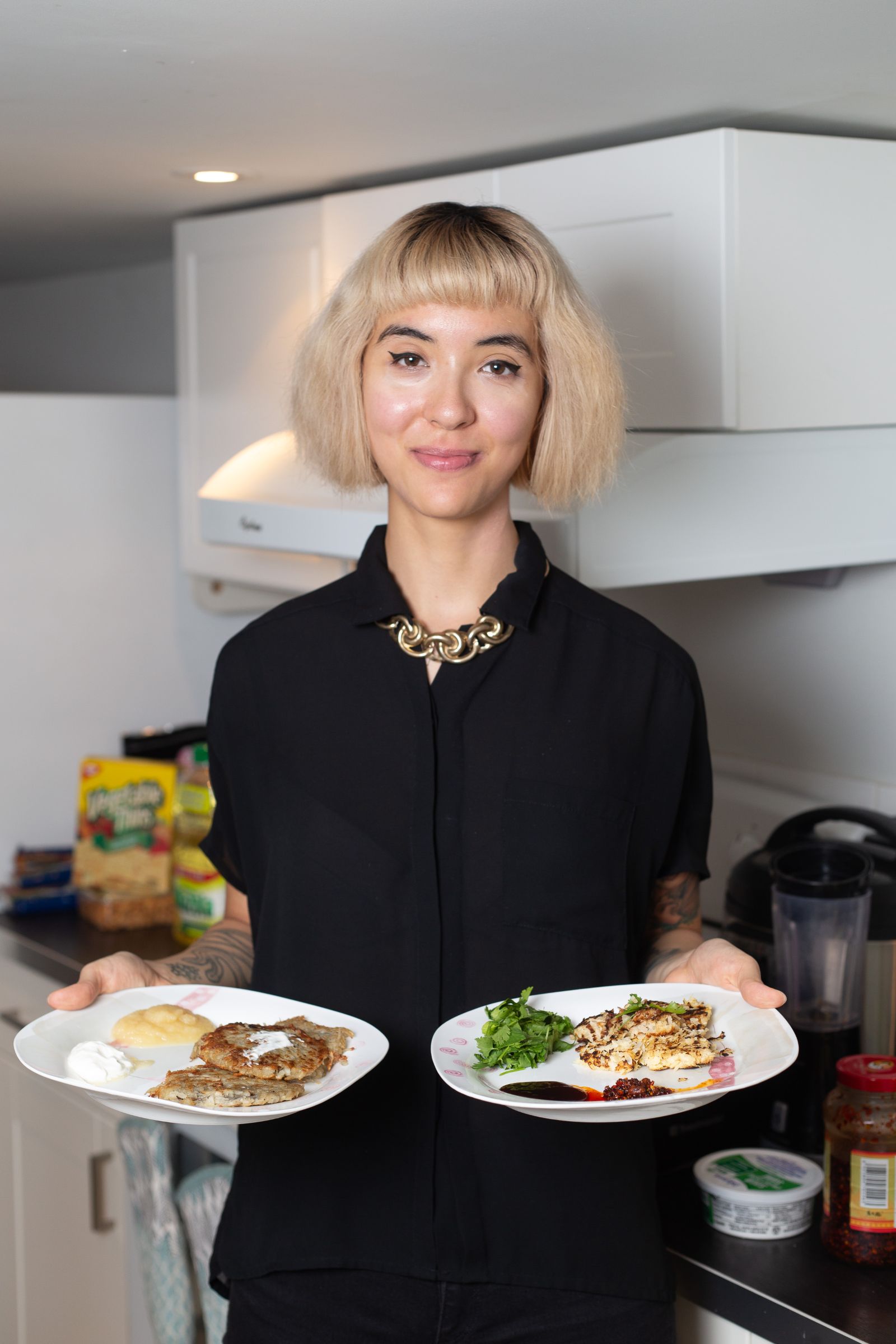
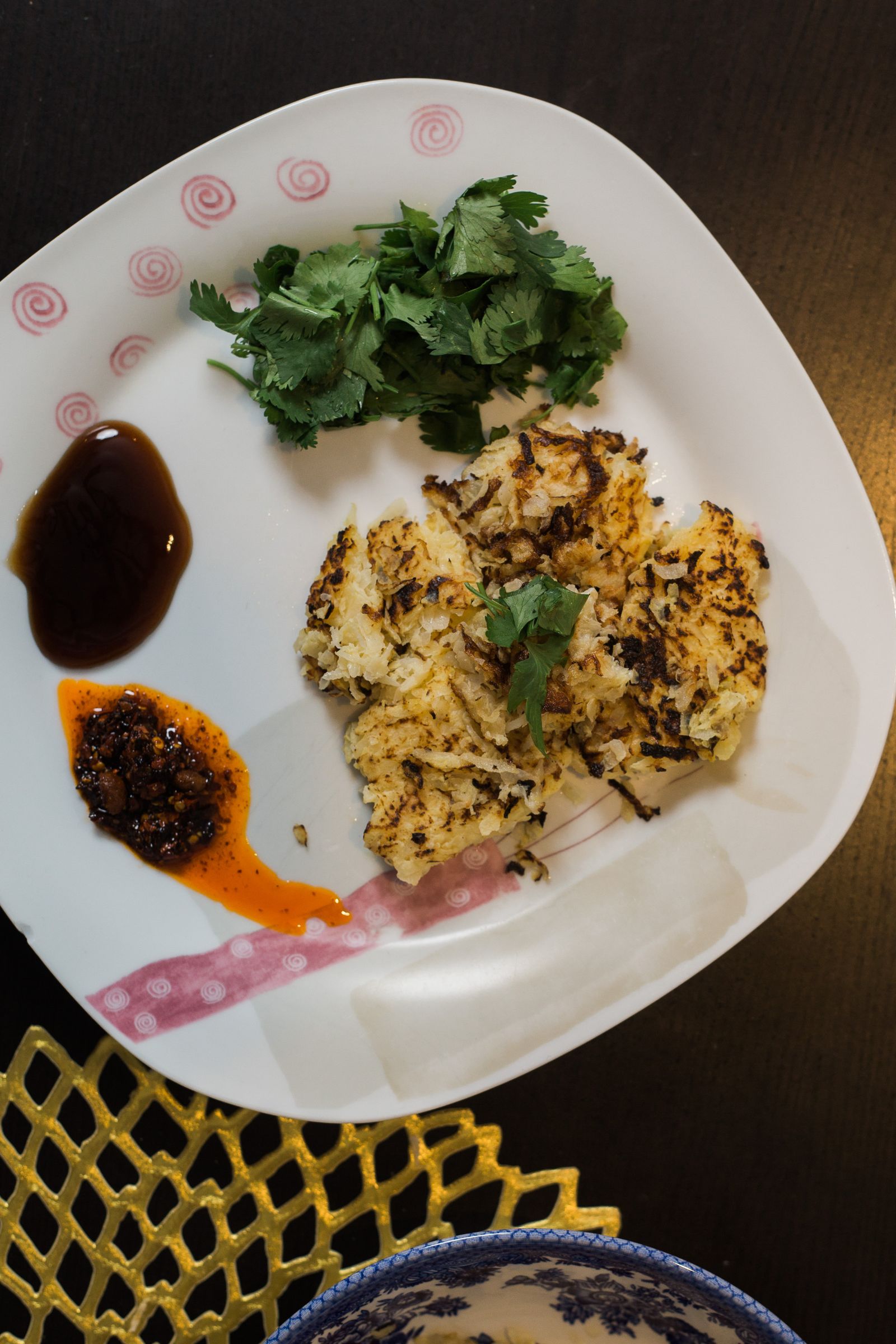
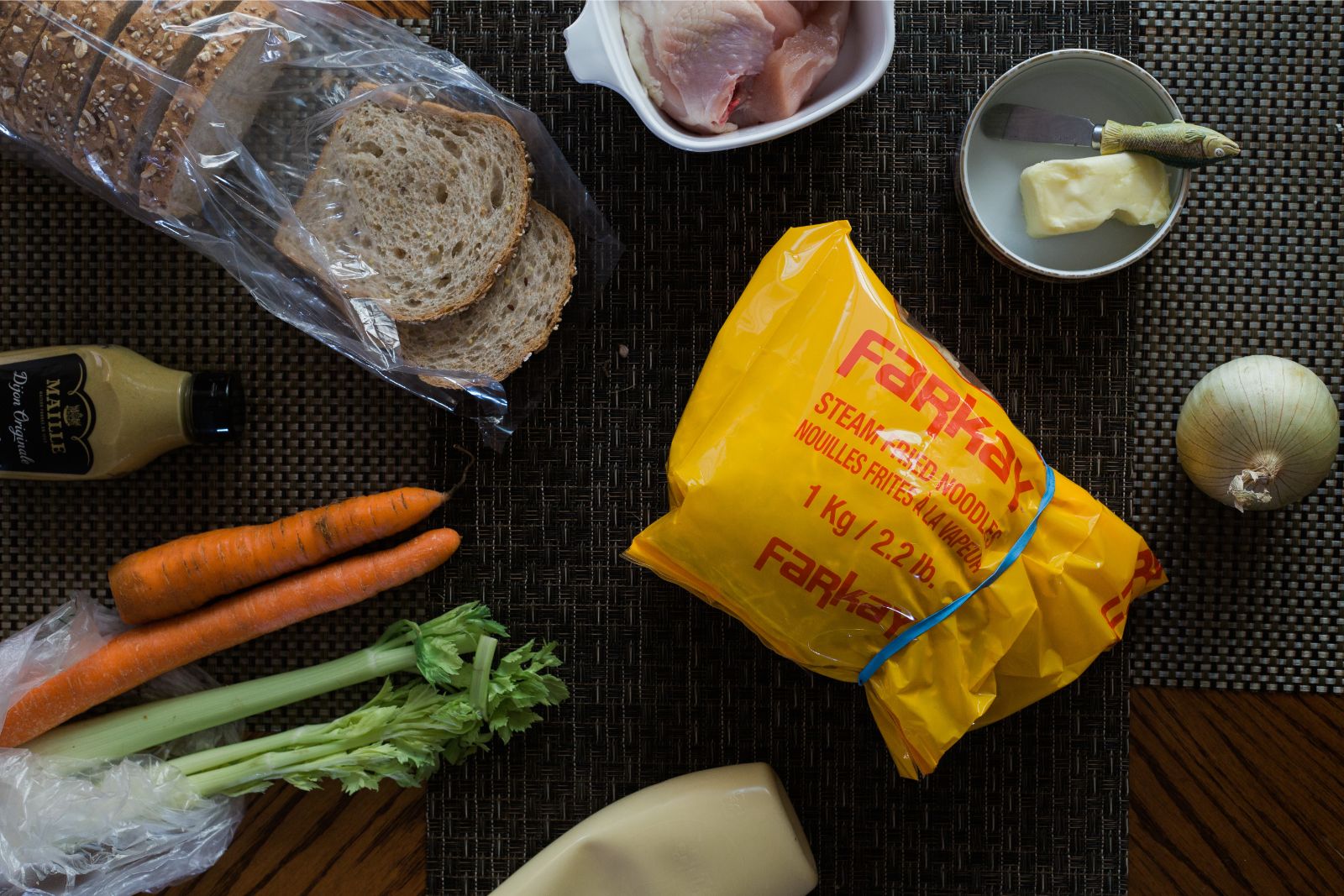
Chow mein sandwiches
Growing up in Steveston and Vancouver respectively, Leslie Komori, 55, and Mayu Takasaki, 67, distinctly remember eating chow mein sandwiches as kids.
The long-time friends continue to eat them today, as the sandwiches still reflect their identities as third-generation Japanese Canadians.
Chow mein is traditionally a Chinese dish made with fried noodles, vegetables and, sometimes, shredded meat, seafood or tofu. However, the chow mein that Komori and Takasaki use for their sandwiches (and eat as its own dish) is specific to Japanese Canadian culture.
It’s bland.
“Around Steveston, it was all just farmland, so I think we ate what was around us, so sandwiches,” she says. “I would eat udon, rice or whatever… but I know that my entire family eats chow mein sandwiches. My aunts, my uncles, it’s just a thing that we all did.”
“I just thought everybody ate chow mein sandwiches.”
It was no different for Komori, whose parents lived in 70 Mile House, a small community in the Cariboo region, before moving to South Vancouver.
Komori says she remembers eating them with her brother and her dad, but she can’t recall why or how her family started eating the sandwiches.
“We had a Komori family reunion, and one thing we made were chow mein sandwiches, so it must be something my family eats,” she says.
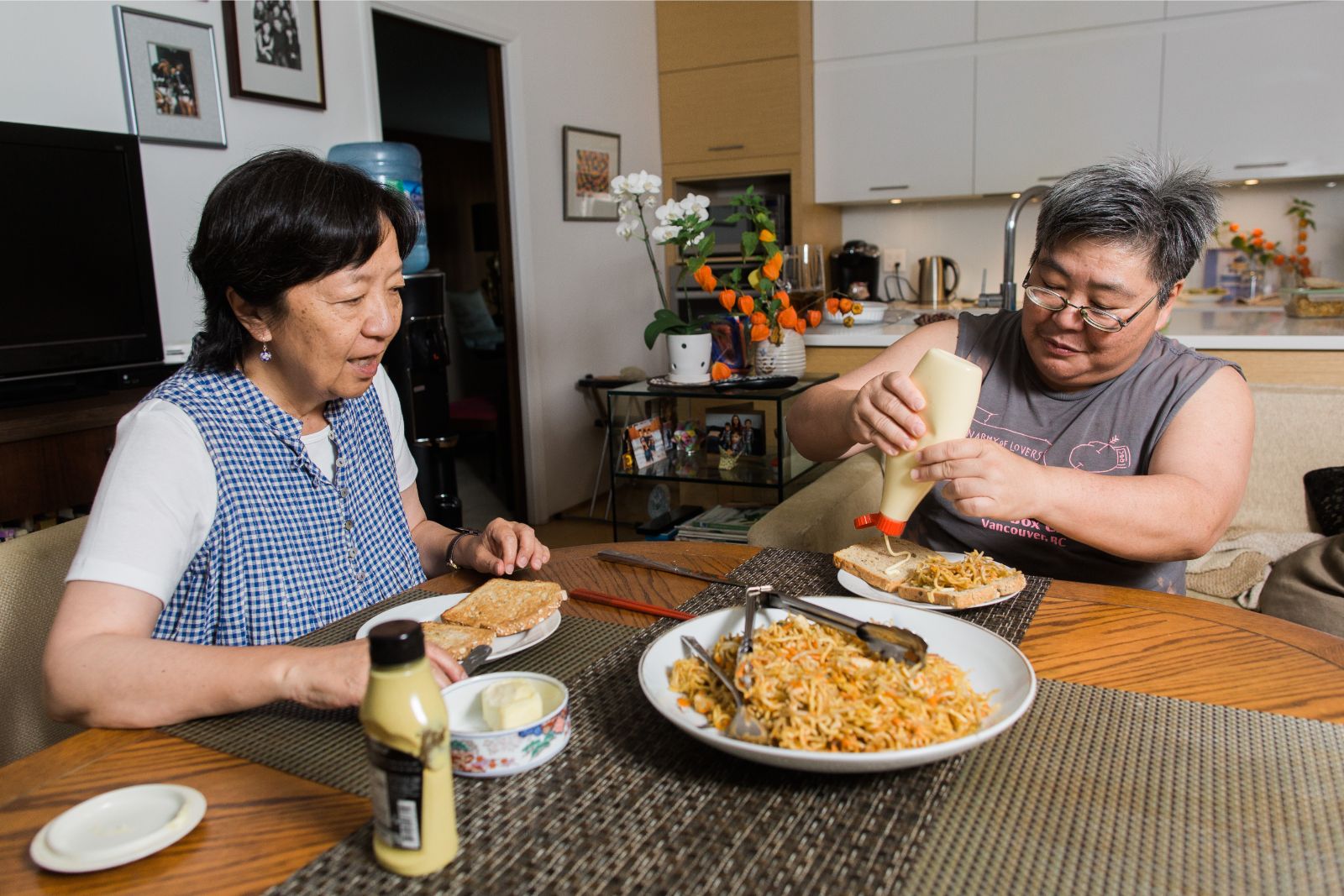
For Komori and Takasaki, chow mein sandwiches are an easy dish to make. Using leftover chow mein, the noodles are thrown onto bread, which has been smeared with butter or mayonnaise, and sometimes mustard as well.
But the recipe starts with making the chow mein: celery, onion and beansprouts.
The three ingredients are repeated over and over again; Komori even apologizes for adding carrots to the chow mein she prepared for my visit.
“You better put a thing [in the article] that’s like, ‘Carrots should not have been in this chow mein,’” she says.
“I thought it was your family’s thing,” responds Takasaki, who is sitting to her right.
“No, we never put carrots in,” interrupts Komori’s mom, Kay Komori, 90 years old and sitting on a loveseat in the centre of the kitchen. “No carrots. Bean sprouts, celery and onions, and the noodles were different too.”
Kay Komori despises chow mein but is quick to correct her daughter’s mistake. She brings it up multiple times in our conversation, while quietly listening to us talk the rest of the half hour.
Although the chow mein is bland due to its limited ingredients and seasoning, it’s a familiar taste for Komori. “There’s nothing that hits the spot like chow mein,” she says.
“It’s not as bland as rice, but it’s halfway between rice and something very flavourful,” explains Takasaki on the taste. “It could be in the middle of your plate to sop up something else.”
For Komori and Takasaki, chow mein dishes are “quintessentially Japanese Canadian” because they started from one diasporic dish and turned into another.
“I do remember taking it to school when I was a kid, and the non-Japanese kids were like, ‘Ooh.’ Because when the noodles start hanging with the beansprouts and everything from the side of your bread, they kind of wiggle,” says Takasaki. “‘Ahh! She’s eating worms!’ [they’d say]. But I didn’t care.”
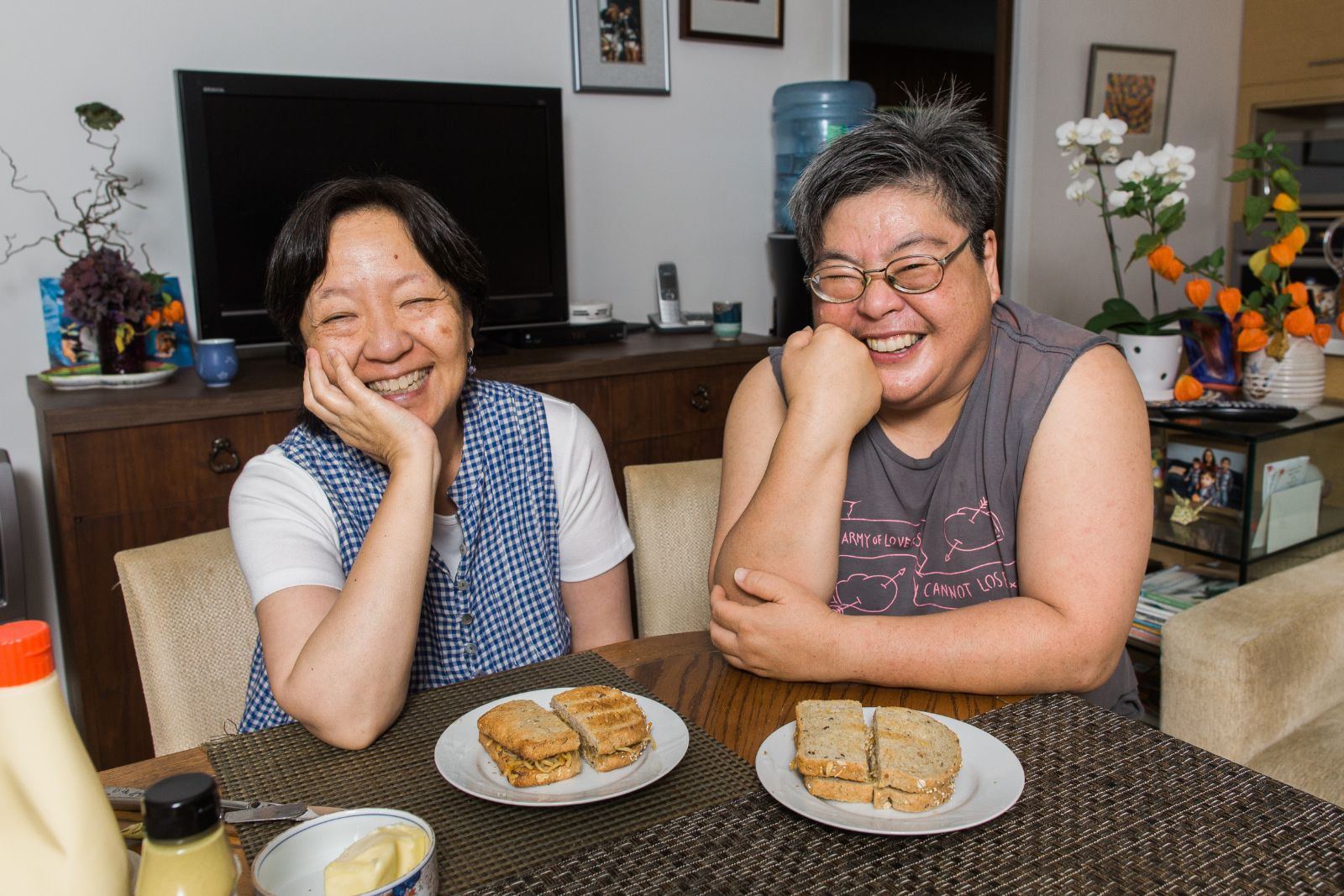
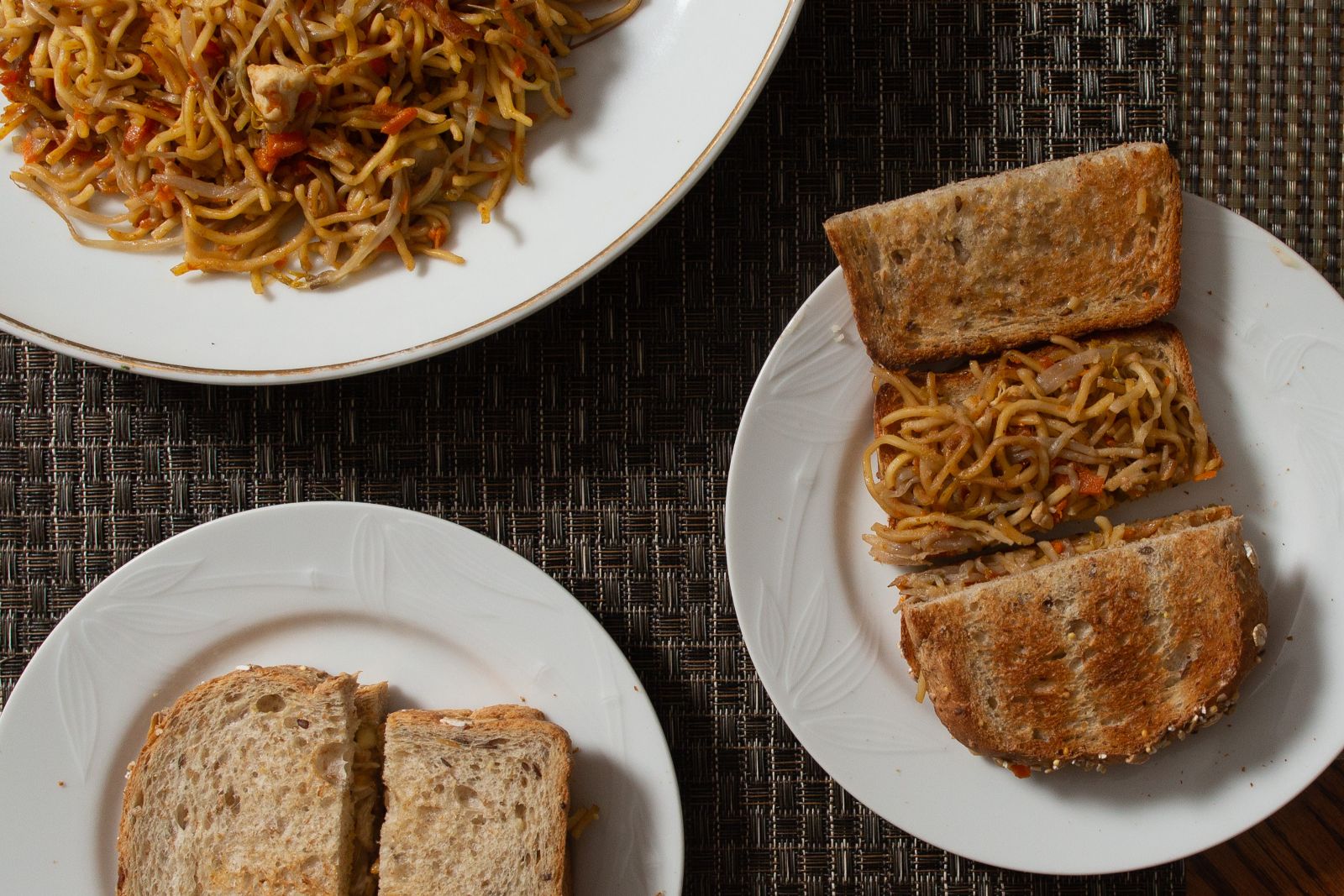
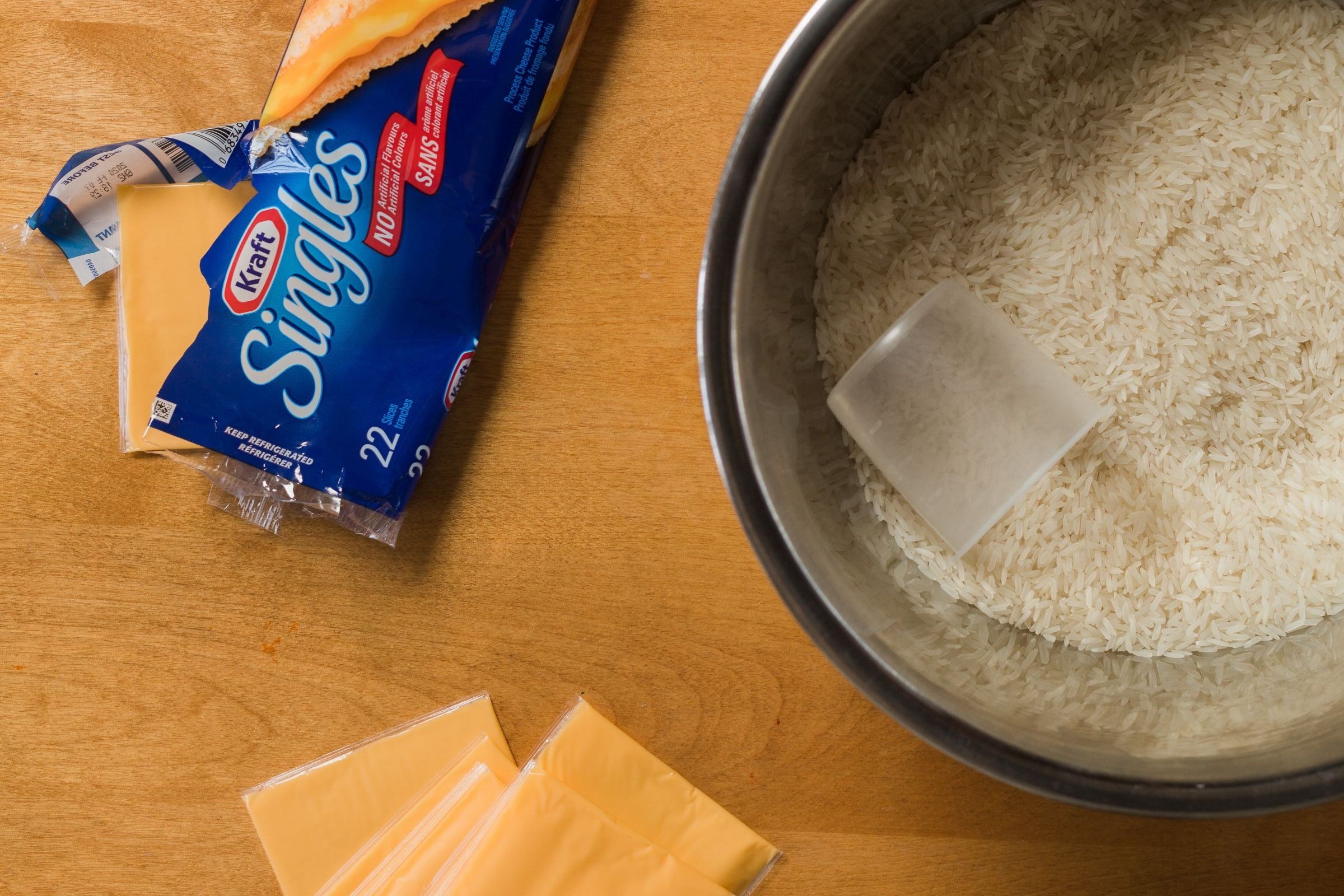
White rice with Kraft Singles
When his mom wouldn’t let him eat grilled cheese sandwiches during dinner, Alger Liang, 21, added Kraft Singles to his rice instead.
“A lot of my friends at school were eating Kraft Singles cheese sandwiches,” he explains. His dish was an experiment, and an attempt to blend in with Western culture.
As a Chinese Canadian, Liang’s family dinners often consisted of white rice, chicken and Chinese greens. As long as there were rice and chopsticks involved, he was allowed to eat it.
Rice with Kraft cheese “was my way of compromising with both worlds, and at the same time, assimilating into Canadian lifestyle, but also keeping my heritage,” says Liang, who adds he stopped eating processed cheese when he entered high school.
The dish is a simple one: freshly cooked rice, Kraft Singles, chopsticks and a bowl. Once the rice is cooked, it’s quick to assemble, too.
Sitting at the kitchen table in his second storey family home in East Vancouver, Liang tears open a package of Kraft Singles.
“We honestly just need one slice,” he says.
As the plasticky orange square plops onto the bed of rice, Liang stirs vigorously. He adds another slice.
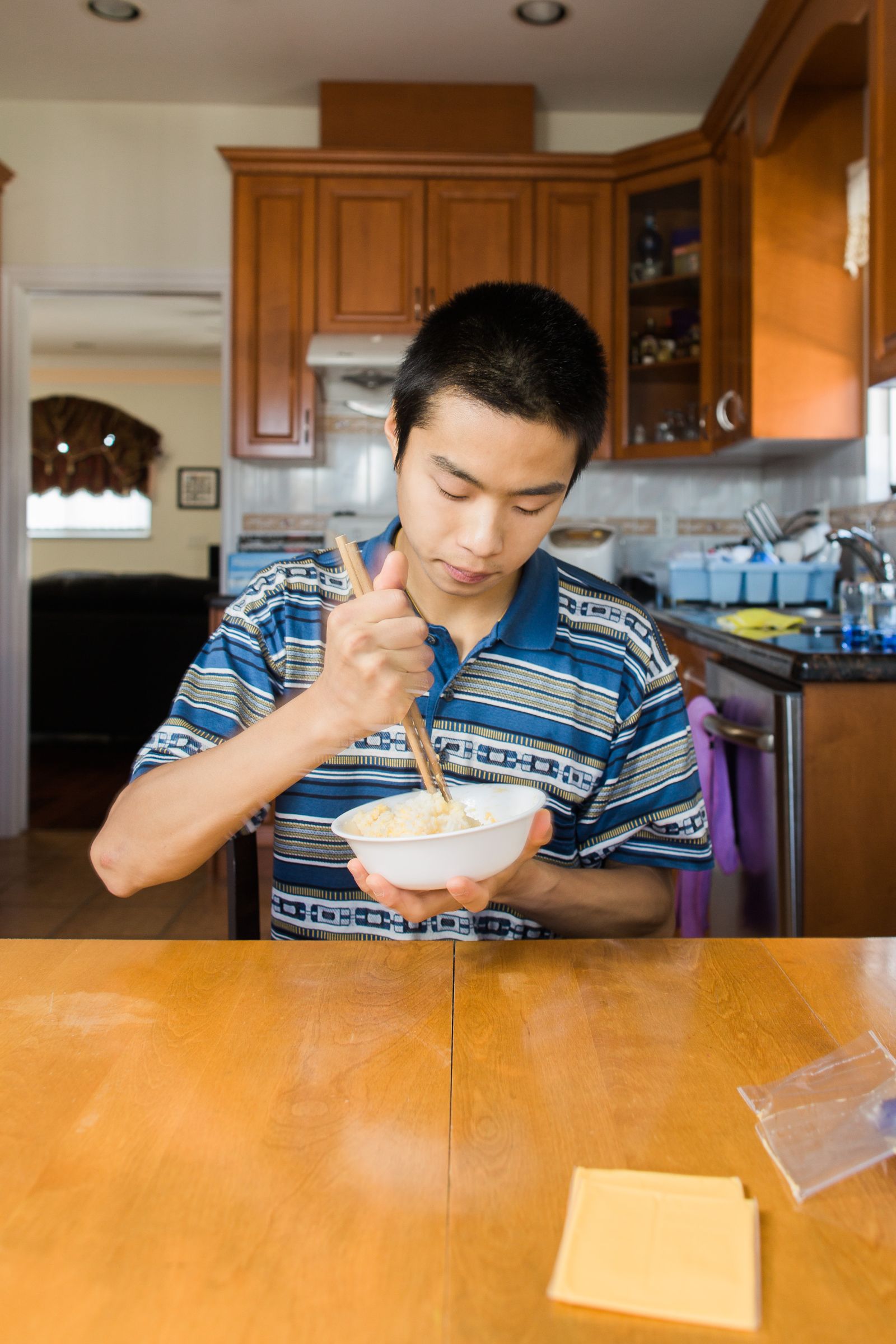
The trick, he tells me, is to add the cheese while the rice is hot. It melts together into a creamy orange and white mess, like a bright, fluorescent version of risotto.
“You have to eat it with chopsticks. That way, the rice and cheese stick together, and you can just stab your chopsticks in and it’s fun to play with,” says Liang.
I ask if he ever eats it today. “Processed cheese and white rice? Nuh uh,” he says. “I still eat white rice, but just as it is.”
“I did try white rice and butter, but it didn’t suit my lifestyle. I didn’t like it.”
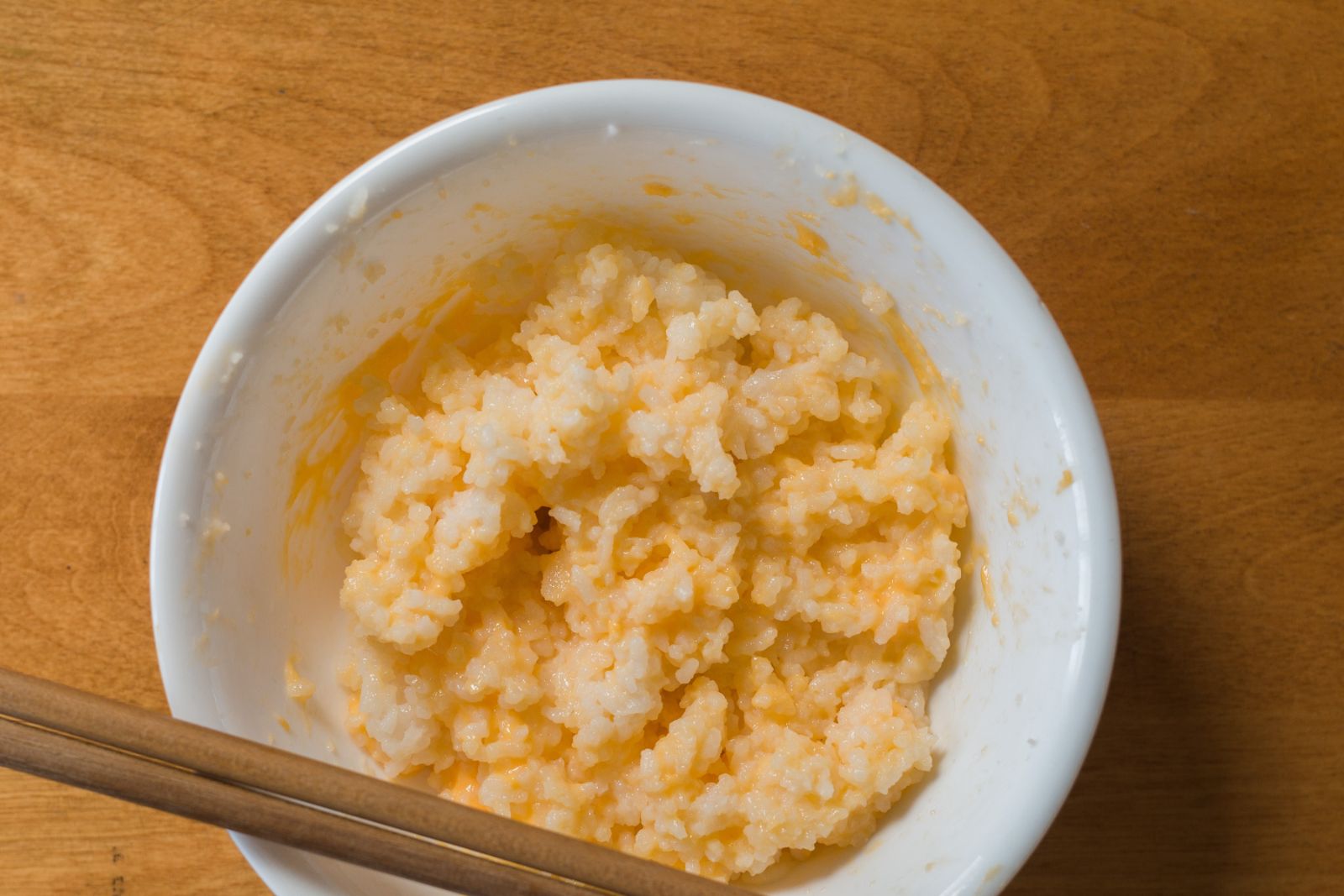
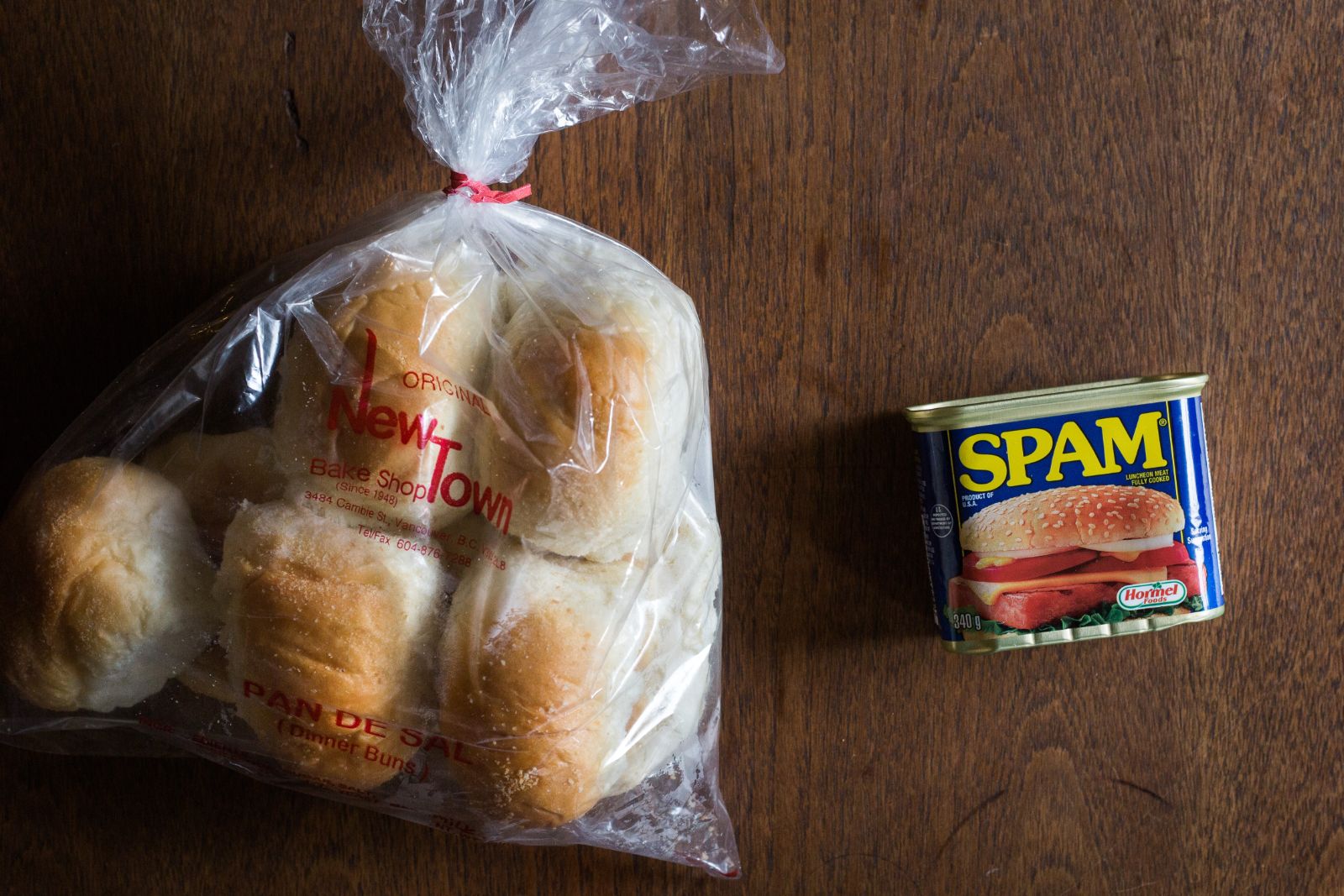
Pandesal with Spam
Spam, baked buns and a thick wooden chopping board sit on the white, narrow kitchen counter. Standing behind the U-shaped kitchenette is Elysse Cloma, 25, a second-generation Filipinx settler.
Eyeing the two ingredients, I look up and ask, “Is this it?”
“Well, there’s butter,” she responds.
I truly don’t know what she’s about to prepare, though I see the dish includes Spam, an American brand of canned cooked pork that’s popular in Filipino cooking.
The dish turns out to be as simple as Liang’s: fried Spam in pandesal, “a Filipinx sweet bread bun.”
“This is my favourite way to eat Spam,” says Cloma. “I chose it because it is a simple example of how Spam blends into the Filipinx diet.”
She adds, “I could even go as far as to say that Spam is part of the Filipinx identity, and it can act as a cultural symbol for the Philippines.”
Cloma peels open the can of Spam, watching as it lands onto the cutting board in perfect rectangular form. She slices it into several pieces, asking how thick I like it.
On a cast iron pan, she fries three slices at a time, leaving it on the stove enough to brown it.
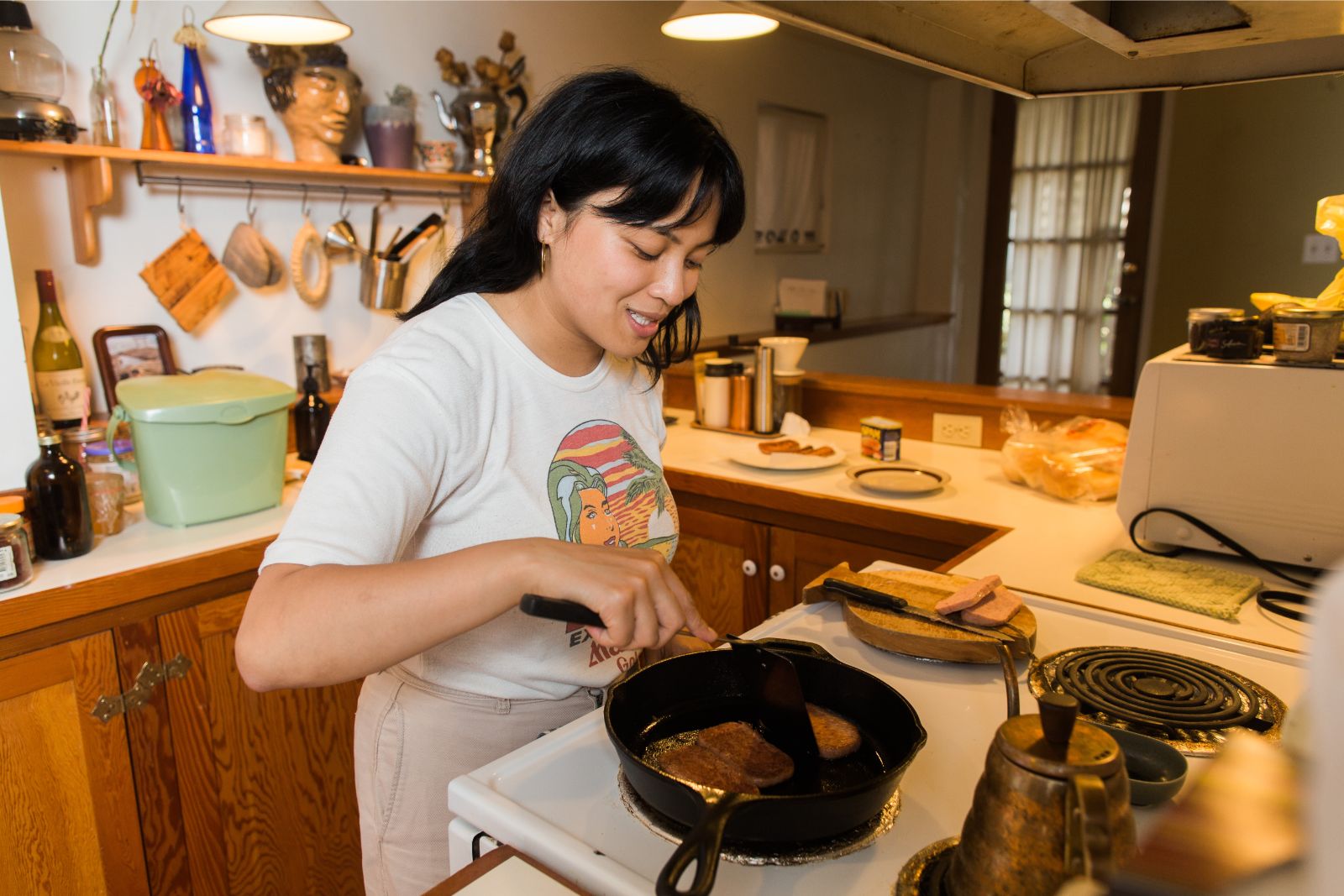
Cloma explains that Spam originally travelled to the Philippines through American military occupation. For her, the ingredient represents American imperialism.
Spam and other canned meats, such as Vienna sausage and corned beef, were staples in her family’s pantry.
“My grandmothers would send dozens of cans of Spam from Canada to our relatives in the Philippines,” she says. “It was a connection to the homeland.”
After frying the Spam, she places it on a plate covered in paper towels to soak up excess grease. The buns are sliced open and browned slightly on the same pan.
To complete the dish, she butters the bread and places a single slice of fried Spam in the centre.
“To me, eating pandesal and Spam means comfort, home, and memories of my grandmothers,” she says. “There’s a sense of cultural pride attached to it, too.”
“In this society I notice there is a lot of individualized shaming over eating processed meat or other foods that are deemed unhealthy. Among second-generation immigrant kids like me, we’ve reclaimed Spam.”
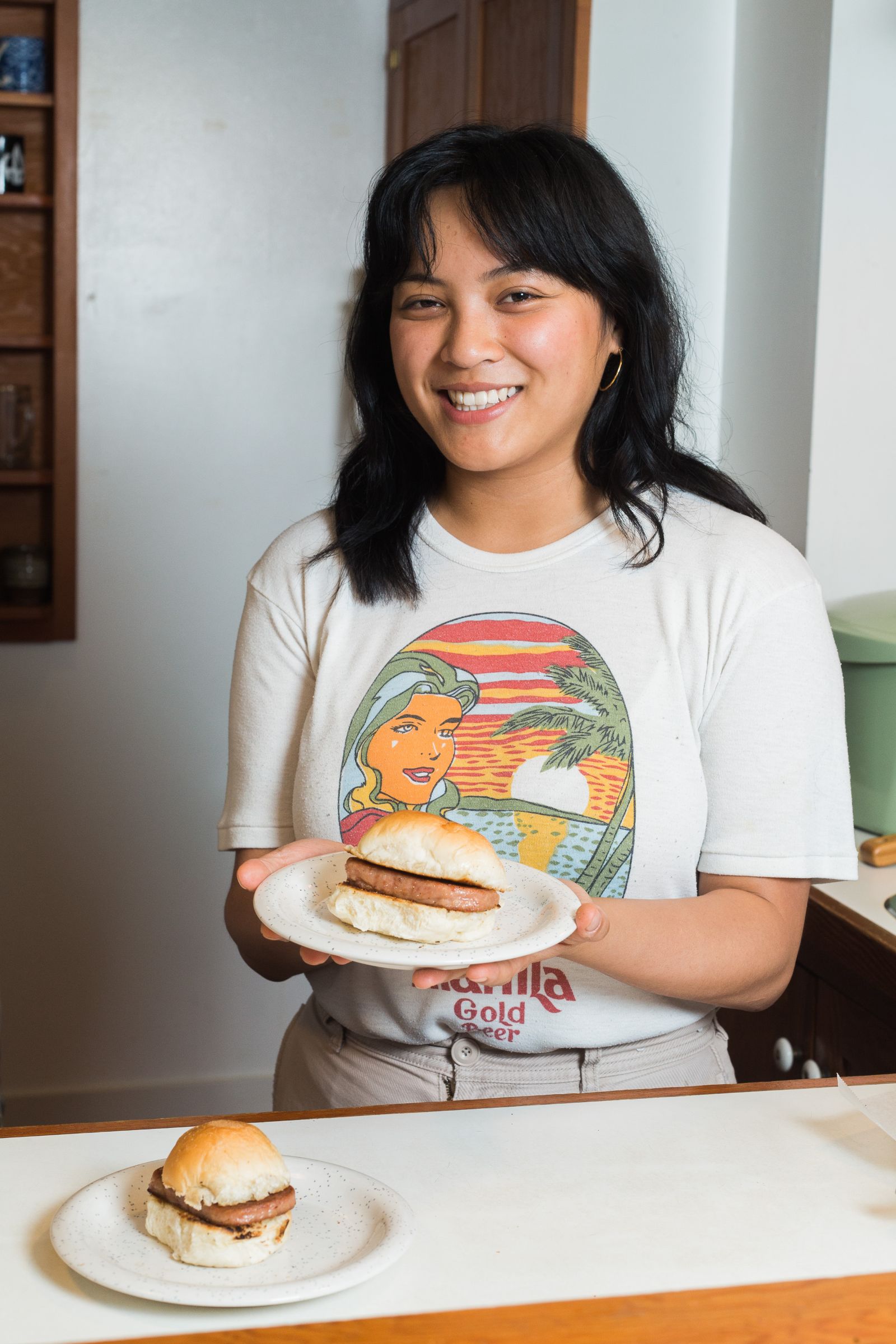
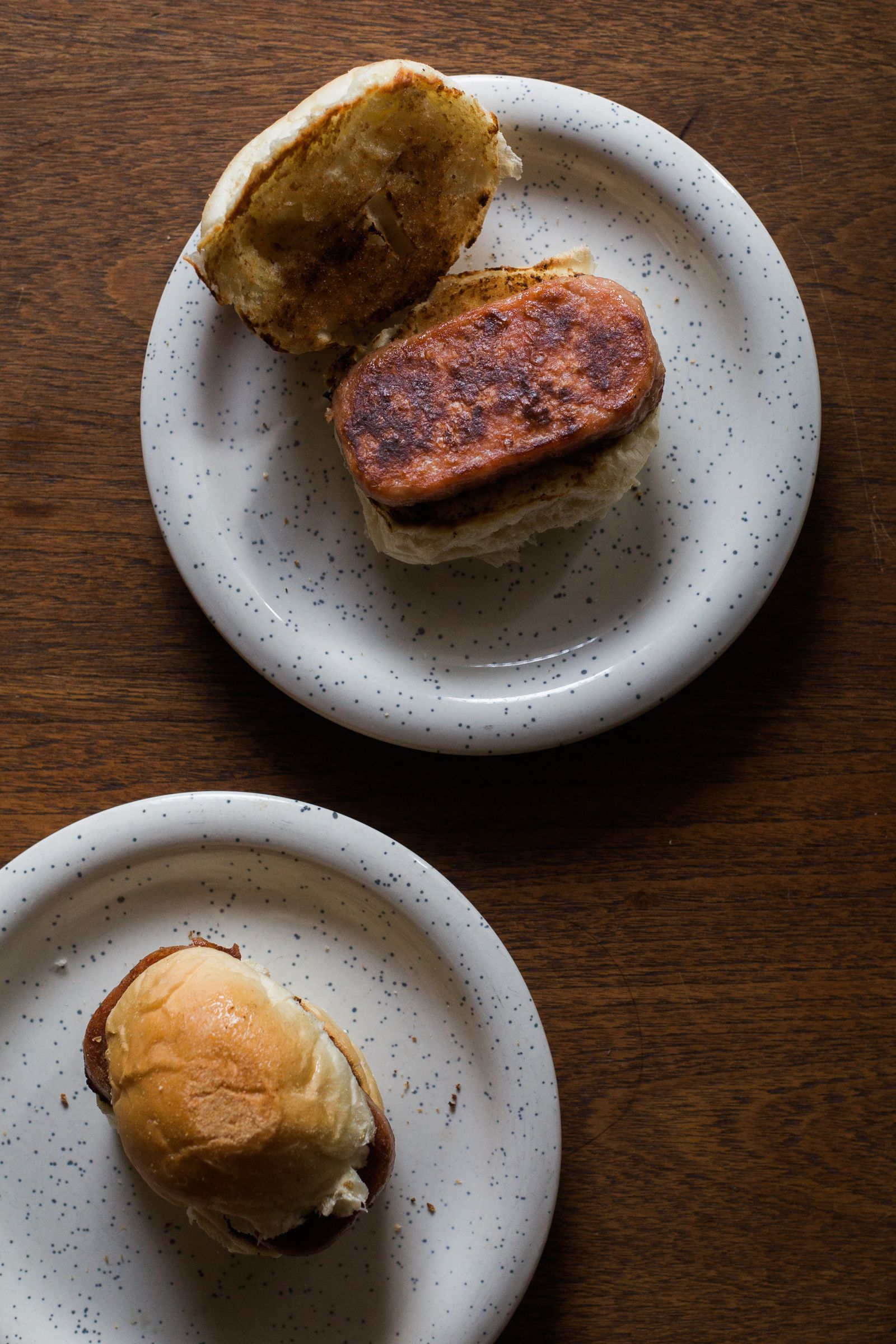
Blended beyond Vancouver
Over the last month, I collected dozens of blended food stories from across North America. It’s evident that these fusions are everywhere, as our environments and cultural connections influence our traditions.
Perogies, sesame oil, hot chili oil, soy sauce and green onions
“I created this dish when I was a teenager growing up in Alberta, where there is a large number of people of Ukrainian descent. I cooked a lot of meals for myself because my parents were busy with that immigrant hustle, and bought frozen perogies from the store (never as good as the freshly made ones by Ukrainian grannies) and then doused them in the typical toppings I would use for Asian dumplings. It’s truly delicious and very quick to make.
“My parents have never had this dish as I think they would consider it an aberration. It means a lot to me because it blends my Chinese heritage with my upbringing in Alberta and also is such a practical yet satisfying dish (and dirt cheap).”
Sally Yue Lin, 29. Victoria, B.C.
Chinese Canadian
Chicken, rice, carrots, soy sauce and pickles
“I think it’s often made together right in the rice cooker, but the one key ingredient that we always ate with it were pickles. Western-style sour cucumber pickles. I’m not sure where my mom learned it from, but I assume through family. I never wondered why pickles were eaten with this rice dish; it was just normal. It wasn’t until I got older than I wondered about this sort of odd pairing. My mom told me that back in the day, it wasn’t always possible for the past generations to get tsukemono [pickled vegetables], as that’s what you’d have with a dish like this. In the absence of tsukemono, they started using the next closest thing.”
Ramses Miki-Hanson, 27. Saskatoon, Sask.
Japanese Canadian
Ketchup and soy sauce
“In my family, there is a technique we use to mix ketchup and soy sauce on your plate, without the soy sauce seeping everywhere. Pour ketchup into a ‘U’ or ‘O’ shape on the side of the plate and pool soy sauce in the ketchup before whipping together with chopsticks! We enjoy this sauce on the side of steaming short-grain white rice, and with any meals usually enjoyed with barbeque sauce — stir fries, steamed vegetables, and grilled meats, are particularly good. Tomatoes and beef with ketchup and soy sauce on rice is one of my favourite dishes.”
Reiko Kelly Pleau, 33. Vancouver, B.C.
Japanese Canadian and Anglo-Franco European settler
Chips and curd rice
“On some South Indian dinner tables, it is common to have a type of fried, crunchy food called sandige, which is a fairly broad category of fried foods. It ranges from coloured stars to clouds of dried onions and grain mashed together. These are often difficult to find in the U.S., and my mom would have my grandmother bring it in suitcases from India when she visited or buy it whenever we went to India ourselves. Making it is totally out of the question since it requires drying in the sun and laborious preparation.
“Because we didn’t always have a lot on hand, we would ration it and only bring it out once in a while. In the meantime, we would buy potato chips and mix it with our rice as a substitute. That meant we’d be mixing things like curd rice with potato chips along with stir-fried vegetables (palya) as well as rasam (a type of stew), which came across as bizarre to a lot of my friends at school.”
Shashank Rao, 22. San Ramon, Calif.
Sankethi-Kannadiga, born and raised in the San Francisco Bay area
Broccoli, Kewpie mayonnaise and Ají
“Growing up I liked veggies, but my mom wanted to feed me even more. We used to dip our steamed broccoli in Japanese mayo [Kewpie mayonnaise] mixed with Ají [a Chilean spicy sauce, pronounced ah-hee]. Being mixed, this was pretty normal for me and was pretty good.”
Ami Scherson, 22. New York, N.Y.
Japanese/Chilean, Jewish and Shinto
Spaghetti thịt kho kimchi
“Stemming from a desperate craving for dry noodles without resorting to instant mi goreng had me rummaging the fridge for what could go together. I first cooked pasta and mixed in pork belly sauce but felt like it was missing something. So I added some texture and nuttiness with the peanuts and kimchi. Also, a ton of hot sauce. I’ve never looked back.
“I think of it as a tale of harmony between growing up as a Vietnamese refugee in Canada and never having been taught proper Western recipes because my mother either didn’t know how to make it or I just didn’t have enough English proficiency to do so myself. Nowadays, through the help of many books and years of ESL, I’ve excelled at English and often assist my parents with translation back into Vietnamese. This food is like the bastardized spaghetti and meatballs, and I’m quite proud of how noodles can travel across so many different cultures.”
Tien Nguyen, 27. Vancouver, B.C.
Vietnamese Canadian, born a refugee in the Philippines
Champorado (a cooked porridge)
“Champorado’s a Filipino breakfast dish and sometimes served during merienda [afternoon snack]. Traditionally served with extra carabao milk [water buffalo milk] and a side of tuyo [smoked fish], it’s related to the Mexican champurrado due to the Mexico-Philippines galleon trade during Spanish colonization.”
Leah Sicat, 36. Martinez, Calif.
Filipina, born and raised in California
Lays potato chips and jook
“If I was to choose one dish to represent the role my father’s cooking has had in my life, I choose homemade jook, or congee, with potato chips. When we are sick, we buy a Safeway chicken and then my dad makes jook from the discarded bones. We dip Lays plain potato chips into the jook. Be it a substitute for, or an adaptation of Chinese donut, the crunch of the chip with the flavourful soup is for me, everything chicken noodle soup wishes to be.
“I’ve often wondered if many families eat potato chips with their jook, or if my dad made up this idea himself. In many ways the idea is obvious, an adaptation of jook with donut to jook with chips is just the substitution of one fried item for a more accessible item that also happens to have a longer shelf life.”
Leilan Wong, 22. Vancouver, B.C.
Cantonese, Irish and English descent
Rice and _______
“It’s been a while since I’ve been home-home: in my parents’ house where I grew up. Sitting in the kitchen one recent afternoon, I noticed that we owned, not one, not two, not three, but FOUR rice cookers. It made me contemplate how important rice is in my life.
“Growing up poor and Asian, I definitely am not a picky eater. I’ll basically eat anything. Therefore, I was a little surprised when I realized I actually have a strong preference in grains. I was watching Oprah for Weight Watchers on TV saying, ‘I love bread!’ over and over again when it dawned on me that I just did not empathize with her sentiment. Bread is… fine. Couscous is… OK. Oats are… passable. But put rice on anything and I become a fiend about it. To my palate, rice elevates the dish to another level.
“This preference has contributed to many experimental fusion dishes. My favourite college experimental recipes were to take meals that would involve wheat products and replace those products with rice. Tuna melt paninis became tuna melts on rice. Spaghetti and meatballs became rice and meatballs (don’t hold the marinara sauce!). The eponymous Philly cheese steak transformed into its Asian counterpart: beefsteak and melted cheese with onions sitting comfortably on a bed of warm white rice.”
Pon-Pon Yeh, 35. Brooklyn, NY.
Taiwanese American
Hot dog teppo maki
“My obaachan [grandmother], Yasuko Shigaki, started making these for the family oshougatsu [Japanese New Year] feast when my sisters, cousins and I were small. I know that we ate and liked plenty of the special new year’s dishes she spent days making, but somehow she also felt the need to add this perfectly Japanese and American dish to menu: thin sushi rolls with long rectangles of hot dogs inside, instead of say, maguro or cucumber. We couldn’t get enough!”
Erin Shigaki, 49. Seattle, Wash.
Japanese American
Mapo doufu
“Growing up in a busy working class immigrant home, there was little time for sharing stories through family time; so when I was in my thirties, my mom gave me weekly cooking lessons whereby I would write down the recipe of whatever dish she was teaching me to make, then we’d sit down and share it. Mapo doufu. I wrote it down in katakana the way she pronounced what I thought were the words, ‘marbled tofu,’ which is what this particular dish of tofu, green pepper and a spicy red miso sauce looked like. Imagine my surprise when, years later, my Chinese-Canadian partner told me that it was actually a Sichuan Chinese dish! It is one of many Japanese Chinese, or Chūka, dishes.”
Terrie Hamazaki, 58. Vancouver, B.C.
Japanese Canadian
Pudding and souse
“Puddin’ an’ souse is a Barbadian dish still enjoyed around midday on Saturdays in Barbados, but in Barbadian circles off the island it is often served at get-togethers. The two components are a spiced sweet-potato based sausage in a pork casing, and a cold pickle of pork off-cuts in onion, cucumber, lime and hot sauce.
“The origin is fairly simple. The more recognizable cuts of pork were sold to the British residents of Barbados and to the wealthier locals employed in their service. The offal was available to those employed in irregular work and with low food security. Because these people had no access to refrigeration they needed means of using the food quickly or protecting it from the bacteria in a hot and humid climate. The pepper sauce, acidic lime and onion served to both preserve the dish... and sometimes mask the taste of early stage decay.”
Vernon Thompson, 53. Vancouver, B.C.
Barbadian heritage
Tamago kake gohan
“I frequently requested egg rice as a side dish for my mom’s white-settler prairie dinners: pot roast, boiled vegetables and egg rice; ‘Best of Bridge’ casserole and egg rice; beef and barley stew and egg rice… I don’t think I cared about how well egg rice paired with the other foods on my plate. I also remember adding crumbled nori to Kraft mac and cheese. Once, while at a white family’s house for dinner, I confidently asked for an egg to crack over my rice. My mom was embarrassed. After a short pause, my dad was forced to describe tamago kake gohan [Japanese rice, raw egg and soy sauce] to our confused friends.
“I remember eating a lot of strange meals that paired Japanese-ish food with food from other cultures. Lots of egg rice with casseroles, but also Kokuho rose or miso soup as side dishes where they didn’t make sense, like with packaged butter chicken or lasagna.
“All of my Nikkei relatives and family-friends lived in Ontario and I think my parents wanted me to connect with my dad’s culture through my food. It kind of worked, actually. I became more curious about Japanese food and Nikkei culture as I aged and to this day, almost all the Japanese words and phrases that I know are food-related.”
Kailey Fukushima, 26. Victoria, B.C.
Japanese and Irish Canadian
Spam and rice
“My mom still hates the smell, but makes it when she knows I’m sad. My dad happily made it for me for breakfast or if we felt ‘fancy’ we’d walk to McDonald’s and get it there (I didn’t realize we were low-key poor). Spam and rice never felt like a poor person’s meal. Instead, it became one of my favorite things to eat and transformed into a happy symbol of nostalgia for my childhood. I still eat it regularly and am always reminded of all my good childhood memories. Now my best friend and I make it every time we meet up (poor college grad bonding) and I’m happy every time I eat it!”
Chyna Oyola, 23. Davis, Calif.
Chinese, Filipinx and Puerto Rican mix who grew up mainly in Hawaii
Got your own blended recipe and story? Share in the comments section below.
Read more: Food, Photo Essays



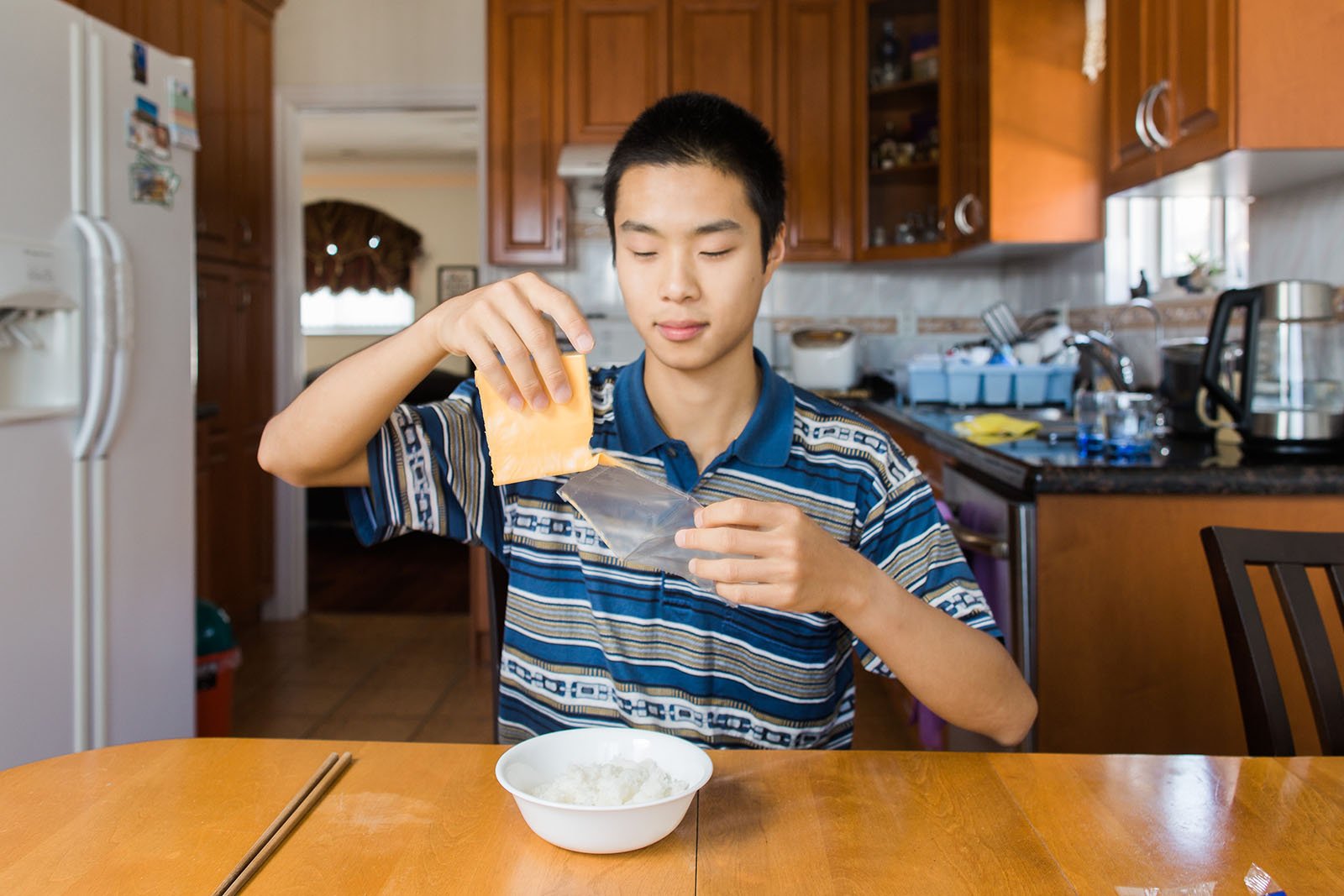












Tyee Commenting Guidelines
Comments that violate guidelines risk being deleted, and violations may result in a temporary or permanent user ban. Maintain the spirit of good conversation to stay in the discussion.
*Please note The Tyee is not a forum for spreading misinformation about COVID-19, denying its existence or minimizing its risk to public health.
Do:
Do not: